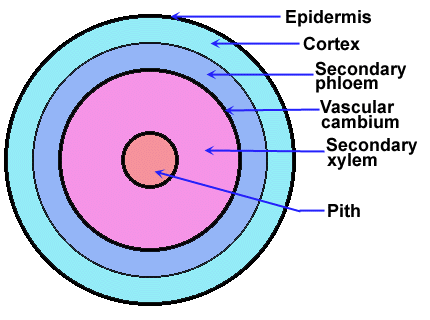| In many plants after the older portions of the plant have stopped elongating, secondary growth is initiated. Secondary growth involves the thickening of the plant axis through the activity of lateral meristems. The end result of secondary growth is increased amounts of vascular tissue. As plants grow larger, more vascular tissue is needed for water conduction and the transport of nutrients. The vascular tissue that results from primary growth is not sufficient, so more vascular tissue is made from the vascular cambium, one of the lateral meristems. The additional vascular tissues do not function exclusively as water and nutrient conduits. Older xylem, in the core of the axis plays an important role in support in larger plants such as woody trees while older phloem, along with tissues produced by the cork cambium, can act as a protective covering for a plant, replacing the epidermis in older parts of the plant. The following diagram shows where the new vascular tissues are positioned in the shoot axis. |

|
|
For simplicity, the primary tissues have not been drawn. Additionally, the cork cambium and the tissues that it produces have not been drawn. The cork cambium is a laterial meristem that encircles the vascular cambium. It produces tissues which function in protecting the surface of the axis. The origin of the cork cambium is complex and will not be addressed in this page.
To find out more about secondary growth, click here: Secondary growth in Shoots For information about secondary growth in roots, click here: Secondary growth in Roots |